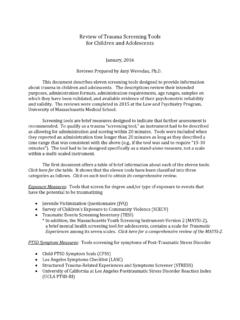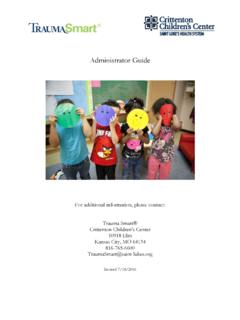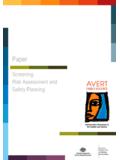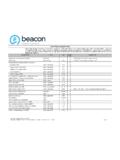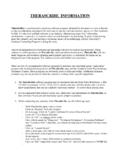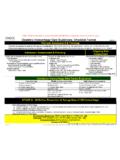Transcription of Seeking Safety - alrest.org
1 Seeking Safety 1 Seeking Safety : A Treatment Manual for PTSD & Substance Abuse Written by Lisa Najavitz Guilford Press, 2002 2 Lisa M. Najavits, Professor of Psychiatry, Boston University of Medicine; Lecturer, Harvard Medical School; Psychologist at the VA Boston Healthcare System & McLean Hospital Seeking Safety is an approved evidence-based practice listed on the SAMHSA NREPP Registry as a treatment for clients with a history of trauma (alone) & substance abuse. Designed for use: Group, individual, male/female, in a variety of settings ( residential, outpatient, in-patient, etc.) 3 Seeking Safety Therapy Seeking Safety is a present-focused, evidence-based, cognitive-behavioral treatment for PTSD and/or substance abuse Treatment developed to be first-stage therapy for clients with either PTSD, substance abuse or other addictive behaviors are appropriate; both disorders do not need to be present in order to benefit from Seeking Safety 4 Treatment Manual Important: Read the Manual Treatment manual comprised of: Overview of theory & treatment model Guidance for individual & group therapy application 25 topic areas addressing coping skill development & recovery Each topic area includes a Safety -oriented skill relevant to both PTSD & substance abuse Each topic is independent of the others Topic areas provide overview for therapist & handouts for participants 5 Seeking Safety Based on Three Stage Model of Recovery (Herman, 1992) Safety is the initial process of the treatment.
2 The only stage which Seeking Safety focuses Mourning & reconnection are later stages of recovery initiated in therapy work separate from Seeking Safety skills 6 Seeking Safety Principles Five Central Principles: as the goal & priority in treatment treatment of PTSD, SA & other addictive behaviors (smoking, excessive spending, gambling, pornography, etc.) on ideals: Restoring lost ideals content areas: Cognitive, behavioral, interpersonal & case management to therapist process 7 Najavitz, L. (2002) Seeking Safety Principles Safety - Examples: Stopping self-harm Gaining control over extreme symptoms Letting go of dangerous relationships Developing self-care 8 Not Part of Seeking Safety Exploring past trauma Okay to name trauma Reference page 46 for keeping discussion of trauma in safe parameters Interpretive psychodynamic work Homework (rather than Commitments ) Goal setting at the start Writing & autobiography Linking every substance use to PTSD 9 Najavitz, L.
3 (2002). Seeking Safety New York: Guilford Press Screening, Assessment & Orientation Screen and assess as relevant to adult, adolescent or child Recommend 1:1 orientation session that covers pp. 88-93 in Seeking Safety manual Orient on how trauma will be addressed Answer individual questions & concerns Review risks/benefits ( worsening symptoms possible) 10 Treatment Format Session Format: Introduction: (5-10 min): BRIEF Quotation: What s the main point of this quote? Topic: Facilitator does not read discussion Grounding techniques & Coping Sheets may be used as needed to Recovery Handout (5-10 min): Leave enough time! Questionnaire 11 Najavitz, L (2002) Quick Reference Checklist before beginning treatment p. 52 List of treatment topics p. 57 Session Format p. 54 Check-in and check out p. 55 Core concepts of treatment (Participant handout) p. 56 End-of-session Questionnaire (Participant handout) p.
4 60 Certificate of Achievement p. 61 12 Seeking Safety Tips for Therapist Stay with the Seeking Safety format ( ) Prior to the session or group, read manual & review facilitator section Keep handouts organized & photocopied Relate material to what is current in participants lives Do more listening than talking Strive for balanced participation 13 Website Resources A website with a wealth of information especially in the areas: Research articles, outcomes, & adherence information. Trauma Resource Institute: Compassion without Borders Community Resiliency Model, Trauma Resiliency Model SAMHSA National Registry of Evidence-based Programs & Practices (NREPP) 14 Session Walk Through: Compassion 15 Session Format 5 min per client. Allows clients to share how they are doing, issues to discuss in main session, consistent start. Quotation to session (briefly) today we will focus on Compassion.
5 Ask about what they think the essence of the quote is. the topic to clients lives (in-depth, most of the session) via the handouts 16 Session Content Goals: Contrast harsh vs compassionate self-talk Handout 1 Rehearse compassionate self-talk Handout 2 Ways to relate topic to clients lives Role play Identify recent situation Create a cassette tape of compassionate self-talk. Discuss questions, feelings, thoughts with Commitment to Recovery Handout (5-10 min): Leave enough time! Questionnaire 17


